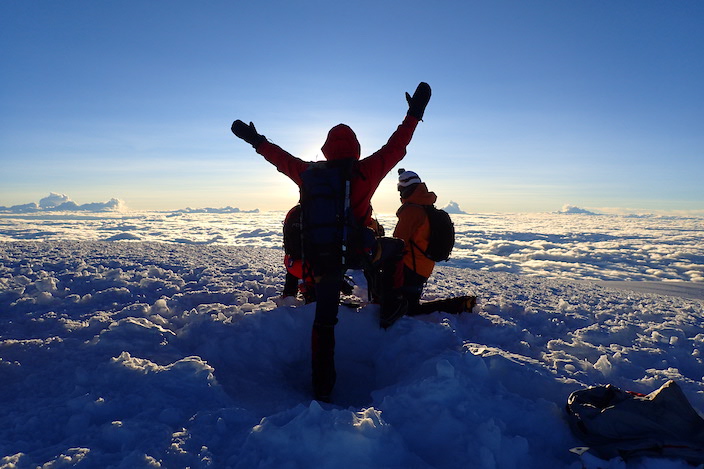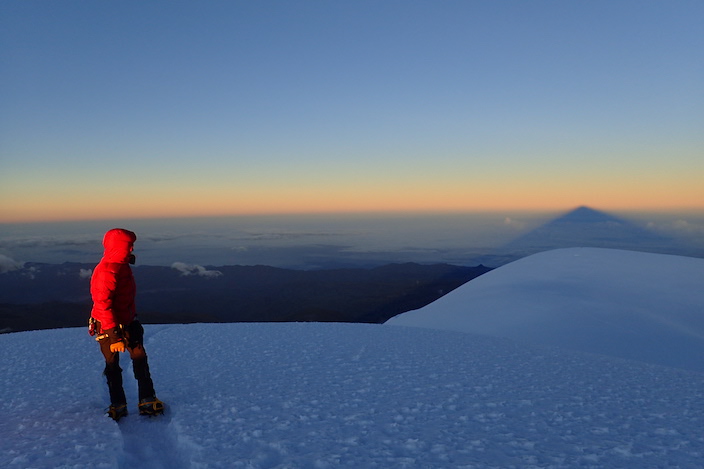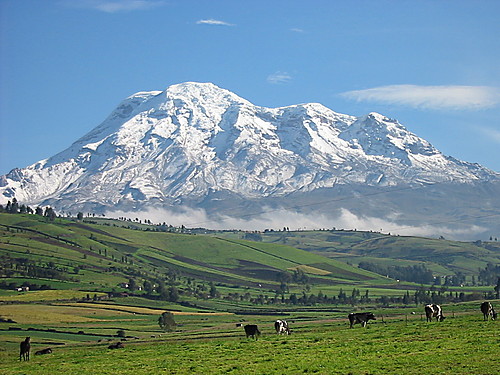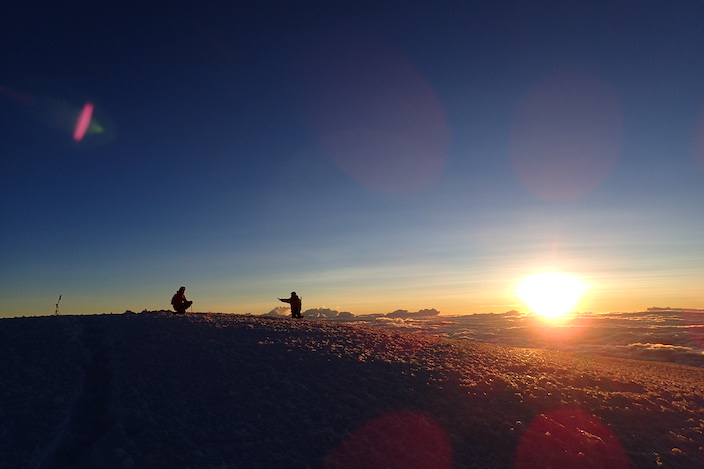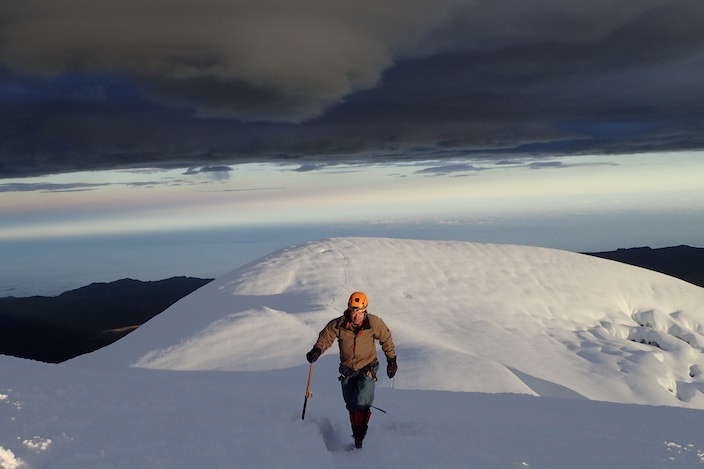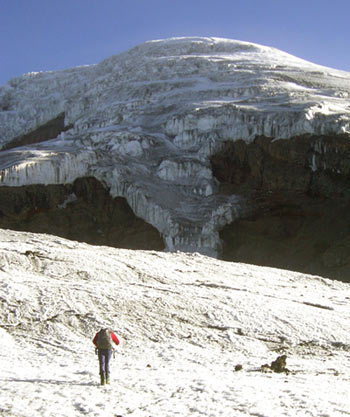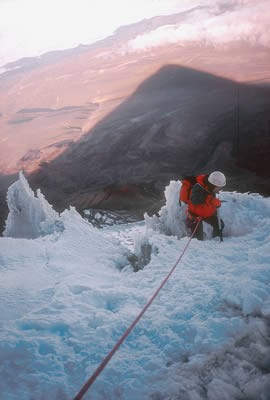Ecuador - Chimborazo Climb Overview Program Structure
Climbing to over 20,000 feet on Chimborazo is a significant undertaking. To join a climbing team for this ascent and have a good chance for success, you will need to know the fundamentals of glacier climbing, be in very good physical condition, and be well acclimatized to at least 18,000 feet within seven days
Most climbers prepare by joining our ten-day Cayambe-Cotopaxi program. In addition to having an opportunity to thoroughly acclimatize, you will also learn or refresh glacier climbing skills and raise your fitness level as you hike two 13,000 and 15,000-foot peaks and then make ascents of two very beautiful 18,000-foot summits.
Trip 1: Cayambe and Cotopaxi Skills Expedition . This 10-day expedition is a great trip in itself and a perfect way to prepare for the big undertaking that Chimborazo constitutes. During this incredible trip, you will spend time exploring the towns, lakes, markets and mountains of the Ecuadorian highlands.
After beginning your acclimatization in 9350-foot Quito, you will continue to increase it by hiking through beautiful páramo (subalpine grasslands and open meadows) on your way to fun rock scrambles to the summits of 13,776-foot Pasochoa and 15,413-foot Rucu Pichincha. You'll then travel to Cayambe, where you'll learn or review glacier skills before attempting the 18,997-foot summit. After a full day of rest, you will then make a two-day climb of remote and beautiful Cotopaxi (19,348 ft / 5897 m). Accommodations: hotel, hacienda, lodge, and hut.
Trip 2: Chimborazo . Once acclimatized, Antisana and Illiniza Climb
The vertical relief of Chimborazo is stunning in contrast to the flat plains surrounding the peak. AAI Collection
Trip Overview
Many people have said, "this trip has it all." The rewards range from rich cultural experiences, great hikes, and aesthetic landscapes, to excellent food, beautiful haciendas, instruction in glacier climbing skills, an ideal introduction to high altitude climbing, high quality snow and ice climbing, and amazing summit views (from the Amazon Basin to the Pacific lowlands).
In sum, the variety and beauty on this trip are awe-inspiring and the personal rewards are of such variety and depth that this is commonly one of those experiences that people describe as "a trip of a lifetime." You can also absolutely guarantee that categorization if you add on a five to seven-day boat-based journey through the Galapagos Islands after your climbs. Many who have made ascents with us here have enjoyed ending their Andean journey with a few days in that wonderful archipelago off the coast of Ecuador.
Zero Carbon Footprint Expedition
This expedition has a zero carbon footprint . Through AAI's Climate Initiative, the Institute pays to offset all carbon emissions incurred by the guides and clients on each trip, including emissions from flight, local transportation, electricity in hotels, and fuel burned to cook in the mountains. To learn more about how this works and AAI’s dedication to environmental protection, click here
Acclimatization We take a conservative approach to acclimatization, and the wisdom of our itineraries is seen every year in the safety record of our trips and the tremendous success rate of our climbers. We have been guiding the high altitude peaks of Ecuador since 1977, and the days we allocate to acclimatization are based on our decades of experience. Though in our first trips we allocated nine days for climbing Cayambe and Cotopaxi, for more than two decades we have been climbing on a ten-day itinerary because we found people are much more comfortable at altitude and enjoy a summit success rate slightly over 30% higher than on a nine-day itinerary. You will find other guide services that offer eight and nine-day trips. Our experience tells us that if you subscribed to that pace, you will save a little money and vacation time but cut your summit success rate by 30% - 50%. Climbing at altitude is quite challenging, and it is important to stack the odds for success in your own favor.
Lodges: If you wish to reserve your own room and/or tent, please let us know. The cost for single accommodations is: $490 for the Cotopaxi Skills Expedition and an additional $160 for the Chimborazo climb. There is no charge for a single tent.
VIDEO
Ecuador - Chimborazo Climb Structure and Routes Ascent of Chimborazo (20,703 ft / 6,310 m) - 4 Days
Looking up at Chimborazo from basecamp.
Chimborazo is Ecuador's highest peak. It is a massive, five-summited mountain rising nearly 11,000 ft above Ecuador's central valley in the western of the country's two parallel cordillera. It is visible from Colombia in the north, from near the Peruvian border in the south, and from far out on the Pacific Ocean. This is a very complex volcanic peak compared to most other peaks, and it offers a wide range of challenges to alpine climbers.
Routes On Chimborazo
Almost everyone who has climbed Chimborazo has done so by one of four routes on the mountain's southeast side - the Whymper Route, the South Ridge, the Thielman Glacier direct, and the Thielman Glacier approach to the South Ridge route (the last two routes were pioneered by AAI guides in the late 1970s). More recently and for a period of several years, those routes fell out of shape because of sequential seasons of low snowfall and warmer temperatures which combined to create rock fall issues. In that period AAI moved to the north face on another route that AAI guides established in 2007.Tungurahua
However, climate change has continued to result in melting ice and poor conditions on the normal route on the southeast side. In 2014, AAI guides took part in a successful expedition to find a new safe route to the summit.
This new route, leaves from the Plaza Roja, near the Carrel Hut, and ascends for 3 hours to the high camp at 17,700 ft / 5,400 m. On this climb we employ porters to carry tents, water and food to camp , while climbers carry some group and personal gear.
Our Climb
After climbing Cotopaxi, you will return to a lodge for another refreshing night in the central valley (9, 000 ft / 2750 m). The next morning you will drive up Chimborazo's flank to reach a small lodge at 13,200 ft / 4,023 m. This lodge sits picturesquely on a grassy plain below Chimborazo and allows you to enjoy a relaxing day and take in views of the altiplano surrounding Chimborazo and nearby Carihuairazo
The historical Whymper Hut provides welcome relief from the elements while on Chimborazo. AAI Collection
The next morning, you will make a short drive through grasslands to the south side of the mountain and then continue higher to the Plaza Roja (15,914 ft / 4,852 m ) located close to the Carrel hut. From there, it will take you about two hours to hike to camp at 17,700 ft / 5,400 m, where you will spend the afternoon preparing for the climb the next day. Climbers help carry equipment to camp, while porters carry the tents and water.
Of your days spent in Ecuador prior to this summit climb, seven days are normally at 15,250 ft / 4,630 m or higher, and by this point climbers should be well acclimatized. Though it is a long climb, being adequately acclimatized will help increase the rate of summit success.
Summit day will start at about midnight, and you will follow the Stübel glacier until it joins the Castle Saddle (18,044 ft / 5,500 m ). This new variant to the normal Castle Ridge route, free from rock fall, makes it a much safer line to the top. From the Stübel Camp it normally takes six hours to get to the Whymper summit. By the time you reach 18,500 ft / 5,640 m, you will have surmounted most of the technical challenges on the mountain and the remainder of the route involves compact and moderately angled snow. The summit crater area is vast and normally covered entirely by soft snow or nieve penitentes.
Chimborazo's summit views encompass Ecuador's many other glaciated peaks, and the views during the climb, the intricacy of the route, and the variety of moderate technical challenges encountered make this ascent of the world's highest equatorial summit an important achievement for both developing and experienced alpine climbers.
The descent to the camp will take about two hours. After returning to the camp, you'll pack up and descend to Plaza Roja, or you may stay another night if necessary. From there, you'll head back to Quito, or if you have an extra day because good weather facilitates an ascent on the first of our two summit days, you will return to the central valley and then travel east, part way down one of the major routes to the Amazon Basin. There you will go to Baños, where the lush vegetation is home to an unusually large variety of orchids, butterflies, and hummingbirds. This is a dramatic contrast to the flora and fauna of the alpine zones where you've been travelling and climbing during the rest of the trip. Based in a comfortable hotel near waterfalls and natural hot baths, you'll enjoy swimming, relaxing, and exploring the Rio Pastaza Canyon that flows to the Amazon. A bicycle descent of part of the canyon is also an option. On your final afternoon, the team will return to Quito and look forward to a final celebratory dinner!
Ecuador - Chimborazo Climb Dates and Details Chimborazo is preferably climbed as a 4-day extension to the Cotopaxi Skills Expedition or the Antisana – Illiniza Expedition . This allows for proper acclimatization before climbing Ecuador's highest peak (20,702 ft / 6310 m).
2025 Chimborazo Extension Dates
Team 6: June 17 - 20, 2025 Confirmed!
Team 7: July 15 - 18, 2025
Team 8: November 11 - 14, 2025
Team 9: November 25 - 28, 2025 Confirmed!
Team 10: December 16 - 19, 2025
Team 11: December 30, 2025 - January 2, 2026
2026 Chimborazo Extension Dates
Team 1: January 2 - 23, 2026
Team 2: February 10 - 13, 2026
Team 3: February 24 - 27, 2026
Team 4: May 26 - 29, 2026
Team 5: June 16 - 19, 2026
Team 6: July 14 - 17, 2026
Team 7: November 17 - 20, 2026
Team 8: December 8 - 11, 2026
Team 9: December 22 - 25, 2026
Details
Pricing: $1350; Price is based on a minimum of 2 people per trip
Max Ratio: 2:1
Capacity: 10
Single Supplement: $160
Private Trip Pricing:
Climbing in Ecuador can be an amazing adventure to share with friends or family! Please contact the AAI Office for pricing and additional information on private trips, or to arrange a customized trip that fits your unique schedule and availability: 360-671-1505 (Toll Free: 1-800-424-2249) or email: [email protected] . We would be happy to set something up for you!
Prerequisites
Climbers registering for Chimborazo must also register for the preceding Cayambe-Cotopaxi Skills Expedition or the Antisana-Illiniza Expedition . Comparable courses may be considered on an individual basis. Excellent physical condition - We will be happy to advise you on a conditioning program; more information is provided in the registration packet.
Program Cost Inclusions and Exclusions Inclusions: Lodging in hotels, haciendas, huts, and tents on a shared basis for the dates of your program (available on a private basis by special arrangement, subject to availability, and at added cost); meals while at huts and while climbing; group cooking equipment; admissions to museums and national parks; group climbing equipment; all transportation during trip, including airport pick ups and drop offs.
Exclusions: Airfare; personal equipment; meals in cities, hotels, haciendas, and lodges; gratuities to guides; government and airport taxes; inoculations; personal insurance; excess baggage.
Flight Information Flight arrangements should be made so that you arrive in Quito on the first scheduled start day of the trip, and you depart the day after the last scheduled day of the trip. Please email or call our Travel Coordinator, Lisa Greif , if you would like assistance with travel arrangements (509-972-4028).
Other Programs & Custom Itineraries in Ecuador Our El Altar Expedition may be of interest to you if you are looking for a more technical challenge on a remote and rarely climbed Ecuadorian peak. We can also provide you with custom itineraries of any length for hiking, trekking, backpacking, scrambling, and climbing.
Ecuador - Chimborazo Climb Trip Extensions Traveling as far as you are to get to Ecuador, you may want to take advantage of your presence there to make a visit to the Galapagos Islands - an area that is on most people's short list of "sites I have to see in my lifetime." You can meet blue-footed boobies close up, swim with penguins and seals, and photograph amazing reptiles, all with no fear of humans. We can also arrange tours to the Amazon Basin and to lodges in the Ecuadorian cloud forest. Tours can range from a few days to a week or more. Call or email the AAI travel coordinator if you'd like to discuss some of your ideas or our recommendations.
Galapagos Islands Cruise
Our cruise itineraries will take you to the isolated Galapagos Islands where you will visit remote locations teeming with unique wildlife and stunning landscapes. We offer 3, 4, 5, and 7 day long cruises to add on to your Ecuador Expedition. No matter how long you wish your Galapagos cruise package to be, daily excursions will be led by top Galapagos National Park guides with wonderful sites of soaring frigate birds, lumbering tortoises, frolicking sea lions, and sleek sharks.
Call or email the AAI travel coordinator if you'd like further details or to book this add-on.
The beauitful yacht you will get to explore the Galapagos Islands on! Golden Galapagos
A native blue-footed booby in the Galapagos Islands. Golden Galapagos
Amazon Rainforest Exploration
Stay in a sustainable premium eco-friendly lodge in the heart of the Amazon rainforest surrounded by a lush biodiversity and untouched natural beauty. Encounter an awe-inspiring array of wildlife, from rare to iconic species, and gain insights from both local experts and naturalist guides. During this experience you will learn all about the culture and traditions of local communites, forging meaningful connections with this beautiful place and people. There are also options for wellness retreats here. These experiences allow you to reconnect with yourself and nature in a serene sanctuary, dedicated to holistic wellness and spiritual rejuvenation. Itineraries for this program are flexible in terms of days and types of experiences.
Call or email the AAI travel coordinator if you'd like further details or to book this add-on.
The unique and serene lodge tucked away in the Amazon Rainforest. Le Selva Eco-Lodge & Retreat
Some of the wildlife you may encounter while exploring the endless Amazon rainforest. Le Selva Eco-Lodge & Retreat
Ecuador - Chimborazo Climb Testimonials "I had a great experience in Ecuador, and enjoyed every minute. The trip was very rewarding regarding beauty and the mountain experiences, but I expected this. What I did not expect were the friendships and relationships that developed between our lead guide, who was a fantastic human being, and the climbers. The guide was a very knowledgeable and experienced guide and I completely trusted him. He was completely committed to the climbers in situations in and out of the mountains, and we traveled effortlessly through his country. The combination of great company and great guiding made this trip a fantastic experience. Thanks AAI!"Mike Brennan, Scranton, PA
"Not only was my guide technically solid on the mountains, he showed balanced decision making skills on each of the climbs. He did a great job tailoring the trip to our individual needs and abilities."George Henderson, Harrisburg, PA
"Our expedition was truly an excellent experience. I believe this was due in large part to the character, skill, and personality of our two guides. They were exceptional, made us all feel like we could push ourselves safely, and helped me experience great personal success."Josh Katzman, Arlington, MA
"AAI is by far the most experienced guide service in the Andes."Adventure Travel Magazine
Ecuador - Chimborazo Climb Related Courses
Program Finder
By Location
United States - Alaska
United States - Washington
United States - California
United States - Nevada
United States - Colorado
United States - Utah
Canada - British Columbia
South America - Argentina
South America - Bolivia
South America - Ecuador
South America - Patagonia
South America - Peru
Europe - Alps and Caucasus
Asia - Nepal and Tibet
Asia - Laos, Thailand, & Vietnam
Asia - China
Asia - Japan
Africa - Tanzania
Pacific and Antarctica
By Program Type
Instructional Courses
Group Summit Climbs
Expeditions
Skills Expeditions
Private Guided Programs
Treks, Tours, & Backpacking
Corporate Outings & Services
Government & Military
By Activity
Rock Climbing
Ice Climbing
Alpine Climbing
High-Altitude Climbing
Trekking and Backpacking
Skiing & Snowboarding
Guide Training & Rescue
Avalanche Training
Departure Month
July
August
September
October
November
December
Difficulty Level
Beginner
Moderate
Intermediate
Advanced
Very Advanced
x
